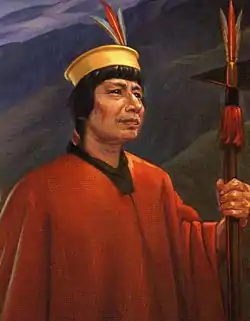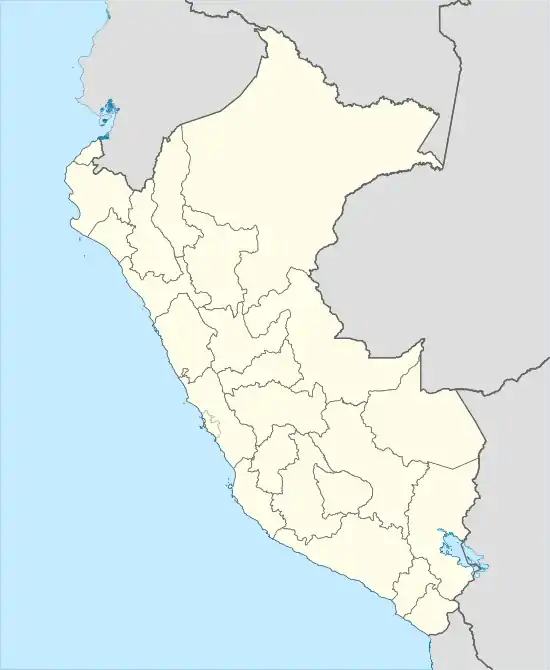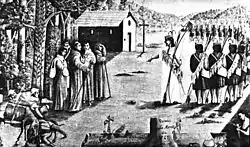Juan Santos Atahualpa
Juan Santos Atahualpa Apu-Inca Huayna Capac[1] (born, c. 1710 - died, c. 1756) was the messianic leader of a successful indigenous rebellion in the Amazon Basin and Andean foothills against the Viceroyalty of Peru. The rebellion began in 1742 in the Gran Pajonal among the Asháninka people. Spanish Peru. The indigenous people expelled Roman Catholic missionaries and destroyed or forced the evacuation of 23 missions, many of them defended, in the central jungle area of Peru. Several Spanish military expeditions tried to suppress the rebellion but failed or were defeated. In 1752, Santos attempted to expand his rebellion into the Andes and gain the support of the highland people. He captured the town of Andamarca and held it for three days before withdrawing to the jungle. Santos disappeared from the historical record after 1752.
Juan Santos Atahualpa | |
|---|---|
 | |
 Location Of Quimiri, One of the missions destroyed by Juan Santos. | |
| Coordinates: 11.032°S 75.317°W | |
| Elevation | 719 m (2,358 ft) |
Santos, Jesuit-educated with both Christian and millenarian ideas, claimed to be the reincarnation of Atahualpa, the Inca emperor at the time of the Spanish conquest of Peru. His objective seems to have been the expulsion of the Spanish from Peru and the restoration of the Inca Empire. He failed in that ambitious goal, but he and his followers succeeded in expelling Catholic missionaries and preventing Spanish and Peruvian settlement in a large area of the Peruvian yungas (high jungle or montaña) for more than one hundred years. "Santos's rebellion had given the Indigenous people of the jungle a previously unknown unity and had awakened in them an ancient taste for freedom and independence."[2]
Early life
Little that can be said with certainty about the early life of Juan Santos. He was an indigenous person (possibly a mixed-blood mestizo), born about 1710, probably in Cuzco, although several other birthplaces have been proposed. He had three brothers. He was educated by the Jesuits in Cuzco. He said that he had visited Europe and Angola, presumably as a servant to the Jesuits. Quechua was his native language and he also spoke Spanish, Latin, and Ashéninka. Santos apparently had contemplated revolution for a long time. He was said by the Spanish to have traveled widely in Peru as a young man to preach his message and sow the seeds of rebellion. Those travels apparently included the Gran Pajonal where Santos learned to speak Ashéninka. The Franciscans later claimed that he fled Cuzco for the Amazon jungles as a fugitive because he murdered his master, a Jesuit priest, although no contemporary evidence backs up that story.[3]
The name Atahualpa comes from the Inca ruler Atahualpa, ruler of the Inca Empire (Tawantinsuyu) at the time of the Spanish conquest in the 16th century. Santos appropriated the names Atahualpa and Huayna Capac as he claimed to be the reincarnation of the former Incan emperors.[4]
The indigenous people
The Asháninka people were the most populous of the indigenous people of the Peruvian Amazon, occupying a territory of about 100,000 square kilometres (39,000 sq mi) from 10 to 14 degrees south latitude in the foothills of the Andes and in the lowlands of the Amazon Basin. They numbered about 52,000.[5] Not all the widely dispersed Asháninka and other groups participated in the rebellion. Juan Santos' rebellion began on the Gran Pajonal (Great Grassland), an elevated plateau, and his area of influence extended into the regions of the Cerro de la Sal (Mountain of Salt); and the Chanchamayo. Other indigenous groups supporting the rebellion were the Amuesha and Nomatsiguenga peoples.[6]
The missions
The area of the rebellion was the nearest and most accessible part of the Amazon Basin with its navigable rivers to Lima, the capital and largest city of Peru, and thus the happenings there were of special interest and concern to the Spanish.
Missionary activities by the Franciscans began in 1635. From the beginning there was opposition from the Asháninka and others. The Asháninka killed several priests and missions were often abandoned due to the hostility of the local people. A determined and extensive attempt to make Christians of the indigenous people began in 1709 as many missions were founded. Franciscan efforts reached the isolated Gran Pajonal in 1733.[7] In 1736, the missionaries reported that they had established 24 mission stations with 4,835 inhabitants.[8] The Franciscans maintained discipline in their missions with armed men, often African slaves. Several of the missions had military garrisons armed with muskets and cannons. The Franciscans also encouraged settlement by imported farmers and artisans who used indigenous slave labor in their work places.[9]
The indigenous people were attracted to the missions for three reasons. First may have been interest in the Christian religion. Secondly, the missionaries distributed steel tools such as axes and shovels which made the life of a slash-and-burn Asháninka farmer easier and which also made it possible for steel tools to be turned into weapons which gave the possessor an advantage over his enemies in war. Thirdly, the indigenous people needed salt as a seasoning and to preserve food and the missionaries attempted to control access to the salt vein at the Cerro de la Sal. Balancing these incentives were the undesirable features of life at the missions. The missionaries attempted to make the semi-nomadic indigenous people sedentary and to regiment strictly their lives. This created problems with food production as jungle soils were infertile and easily exhausted and a sedentary people had difficulty producing sufficient food. However, the most serious problem of the reductions, as the Spanish called the policy of encouraging or forcing indigenous people to live in permanent settlements, was the pandemics of European diseases which ravaged the populations of indigenous peoples throughout the Americas, especially those living in close proximity to each other in settlements.[10] For example, an epidemic at the mission of Eneno in 1722-1723 resulted in a decrease in population at the mission from 800 to 220 as most of the inhabitants died of the disease or fled the settlement.[11]
Rebellions against the Franciscans and the missions were frequent. The most recent of the revolts before the rise of Juan Santos was in 1737. An Asháninka headman named Ignacio Torote destroyed two missions killing 13 people, including five priests. A survivor reported that Torote gave his reasons to a priest for the rebellion, "you and yours are killing us every day with your sermons and doctrines, taking our freedom away." [12] Torote's twenty followers were captured and executed by the Spanish and he disappeared into the jungle.[13]
Rebellion
In May 1742, Juan Santos along with a Yine (Piro) named Bisabequi appeared at the Franciscan mission called Quisopango at the southern edge of the Gran Pajonal a few kilometers north of the 21st century town of Puerto Ocopa. What he did or said is unknown but he gained support among the Amuesha and other indigenous people in addition to the Asháninka. Within a few days half a dozen missions in the Cerro de la Sal and Chanchamayo region had been abandoned by the indigenous people.[14]
In June, a priest, Santiago Vásquez de Calcedo, journeyed to Quisopango to meet Juan Santos. From that contact and others reported by indigenous leaders, some of Santos's personality and aims became clearer. Santos said that he was a Christian and recited the creed in Latin. He had come to the Pajonal to reclaim "his kingdom." He claimed to be a reincarnation of Atahualpa, the last Inca emperor. He was going to effect that reclamation with the help of indigenous people. Santos said he opposed violence, but he was going to expel the Spanish and their African slaves from Peru with the help of the British. (There is no evidence Santos was in contact with the British, but his claim of help from them was disturbing to the Spaniards.) The scholar Stefano Varese says the Santos's "attitudes were those of a moderate man" full of "mystical inspiration." He based his rebellion, typical of Millenarianism in colonial societies, on religion.[15] Juan Santos promised that the rebellion would bring peace and prosperity to all the Andes, beginning in the jungle and spreading to the highlands and the coast. Juan Santos said that the culmination of his rebellion would be his coronation as Sapa Inca (supreme ruler of Tawantinsuyu).[16]
Santos's aims seemed more directed at the highland peoples who had been subjects of the Inca Empire rather than the Asháninka and other jungle peoples who had not been subjects and probably did not share his ambitious goals. As told to two African captives, their motivation in supporting Santos was that "they wanted no priests and they did not wish to be Christians." Santos's initial hostility to Africans changed quickly and several former African slaves of the Franciscans became important supporters of the rebellion. The Africans were valued for their knowledge of European weapons and battle tactics. Many indigenous people and mestizos from the Andes also joined the rebellion.[17][18]
Victory

The Franciscan priests, the laymen, and the converts living at twenty-one of the twenty-three missions in the central jungle fled to two surviving missions: Quimiri, near the 21st century city of La Merced, and Sonomoro near the 21st century town of San Martin de Pangoa. Juan Santos moved his base of operations 110 kilometres (68 mi) east from Quisopango to the less isolated and more strategically located mission of Eneno on the Perené River in the Cerro de la Sal region.[19]
The first violence of the rebellion took place in September 1742 when a locally gathered militia force headed by three Franciscans sallied forth from Quimiri and were ambushed and killed. That same month two Spanish forces of regular soldiers were dispatched from the Andes to suppress the rebellion, but they failed to find Juan Santos. The Spanish built a fort in Quimiri and left 80 soldiers with artillery while most of the army withdrew to the city of Tarma in the Andes. Santos surrounded the fort and offered the Spanish safe passage to Tarma, but they rejected the offer. Attempting to supply the fort with food, a Spanish relief force from Tarma was ambushed and 17 men killed. Later, the desperate, starving Spanish soldiers decided to flee the fort, but they were intercepted by the indigenous forces and all 80 were killed. When a relief force of 300 men arrived at the fort in January 1743, they were greeted with cannon fire from the indigenous forces. The relief force withdrew. Only Sonomoro among the former missions remained in Spanish hands and Santos and his followers were left in uncontested control of a large swath of territory for more than two years. [20] [21]
In 1746, the viceroy José Manso de Velasco sent a force of nearly 1,000 men into the Asháninka territory. It was defeated more by the rain and the jungle rather than the indigenous army, estimated by the Spanish to number 500 but in reality only a widely dispersed part-time force of combatants. After that failure, the Spanish gave up attempts to suppress the rebellion, but instead built fortresses in Chanchamayo and Oxapampa to prevent the rebellion from expanding into the Andes highlands and its relatively large population. Nevertheless, incipient revolts broke out in three highland towns and were brutally repressed by the Spanish. A Franciscan expressed the Spanish fear. "If this (Santos)...headed for Lima with 200 Indian archers, one could fear...a generalized rebellion among all the Indians in the provinces of the Kingdom." In 1750, the Spanish sent another military expedition into rebel territory and it was easily defeated by the guerrilla tactics of the Asháninka and their allies.[22]
In 1751, groups of Asháninka and their Piro allies advanced southward in what was more of an immigration than a military operation to take back former territories in the region of the towns of Satipo and Mazamari, and forcing the evacuation of the Spanish fortress in Sonomoro, the last of the 23 missions in the central jungle.[23] In August 1752, Santos's rebellion reached its high water mark when he led an Asháninka force which captured the highland town of Andamarca in Jauja Province and held it for three days before departing. Hoping perhaps to incite a highland rebellion, Santos avoided taking the lives of the residents and priests in the town.[24]
Having reclaimed their territory and expelled the Spanish, the active phase of the rebellion ended. The area liberated by the indigenous people from the Spanish was about 200 kilometres (120 mi) from Pozuzo in the north to Andamarca in the south, marked by where the yungas merge with the high Andes. It extended about 170 kilometres (110 mi) eastwards to the Ucayali River and its upstream tributaries.[25]
Death and legacy
The date and circumstances of the death of Juan Santos are unknown. After his capture of Andamarca in 1752, he disappeared. Most Spanish sources believe that he died in 1755 or 1756, although a Franciscan priest thought that he was still alive in 1775. In 1766, two Asháninka followers of Santos said that "his body had disappeared in a cloud of smoke." A small pile of rocks on the Cerro de la Sal commemorates him.[26]
In 1788 the Spanish endeavored once again to enter the territory that the Santos rebellion had wrested from them. The Spanish established two fortresses on the southern edge of the Chanchamayo region in Vitoc and Uchubamba. However, not until 1868 and the founding of the city of La Merced (near the old Franciscan mission of Quimiri) were most of the Chanchamayo and the Cerro de la Sal regions opened up to settlement by non-indigenous people.[27]
| Wikimedia Commons has media related to Juan Santos Atahualpa. |
References
- Brown, Michael F.; Fernandez, Eduardo (1991). War of Shadows. Berkeley: University of California Press. p. 32. ISBN 0520074483.
- Varese, Stefano (2002). Salt of the Mountain. Norman: University of Oklahoma Press. p. 107. ISBN 0806134461.
- Varese 2002, pp. 87-90.
- Hinnells, John R. (1991-12-12). Who’s Who of World Religions. Springer. p. 198. ISBN 9781349095001.
- Vigil Oliveros, Nila (2018). "Poblamiento y ocupacion de la Selva Central del Peru". Anales de Antropologia. 52 (2): 157.
- Jones, Cameron D. (2016). "The Evolution of Spanish Governance during the Early Bourbon Period in Peru". The Americas. 73 (3): 325, 331. Downloaded from Project Muse.
- Varese 2002, pp. 82-85.
- Jones 2016, p. 331.
- Veber, Hanne (2003). "Ashaninka Messianism: The Production of a Black Hole in Western Amazonian Ethnography". Current Anthropology. 44 (2): 192.. Downloaded from JSTOR.
- Jones 2016, pp. 331-333.
- Brown and Fernandez 1993, pp. 28-29.
- Veber 2003, p. 194.
- Verese 2002, p. 87.
- Varese 2002, pp. 88-91.
- Varese 2002, pp. 90-92.
- Brown and Fernandez 1991, p. 44.
- Brown and Fernandez 1991, pp. 44, 48-49.
- Veber 2003, p. 195.
- Jones, Cameron David (2013). "In Service of God and King: Conflicts between Bourbon Reformers and the Missionaries of Santa Rosa de Ocopa". Dissertation. Ohio State University. pp. 70, 81–82. Retrieved 1 August 2020.
- Jones 2016, pp. 335-336.
- Jones 2013, pp. 81-86.
- Varese 2002, pp. 100-105.
- Brown and Fernandez 1991, p. 49.
- Varese 2002, pp. 105-106.
- Google Earth
- Varese 2002, pp. 106-109.
- Varese 2002, pp. 107-109.
Bibliography
- Andean Worlds: Indigenous History, Culture, and Consciousness Under Spanish Rule, 1532-1825. Kenneth J. Andrien. 2001. University of New Mexico Press. ISBN 0-8263-2359-6